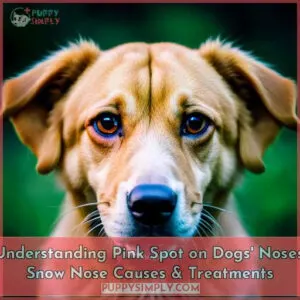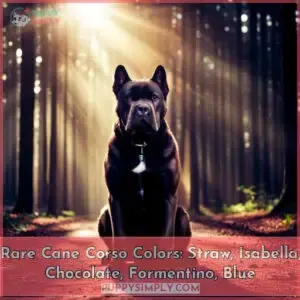This site is supported by our readers. We may earn a commission, at no cost to you, if you purchase through links.
Surprised to see dogs with pink noses? It’s not as rare as you might think! In fact, several breeds of pups have a natural tendency towards having rosy snouts. However, for other black-nosed dogs, the fading of their nose color could be due to certain conditions such as hypopigmentation or snow nose.
So if your pup has recently lost pigment in their muzzle and is looking more like Rudolph than Rover lately, never fear! We’ve got everything you need to know about these adorable canines with pink noses right here.
Table Of Contents
- Key Takeaways
- Breeds With Pink Noses
- What is Dog Snow Nose?
- Is Snow Nose Harmful?
- How to Prevent Snow Nose?
- Can Snow Nose Be Treated?
- What to Do if Your Dog’s Nose is Changing Color?
- Why Does Snow Nose Affect Certain Breeds?
- How to Care for a Dog With Snow Nose?
- Can Snow Nose Be Linked to Skin Cancer?
- Frequently Asked Questions (FAQs)
- Conclusion
Key Takeaways
- Some dog breeds have natural pink noses, including Labrador Retrievers, Australian Shepherds, Irish Setters, and Bull Terriers.
- Snow Nose is a condition that causes a lightening of color in canine noses, typically occurring in winter months, and is not harmful or painful for your pet.
- Genetics play an important role in preventing Snow Nose for some breeds, and shedding prevention is key for those prone to the condition.
- Pink noses are a cosmetic trait that can vary between breeds and even within the same breed, and are not associated with any health issues.
Breeds With Pink Noses
You may be familiar with some of the most popular dog breeds that have pink noses, such as Labrador Retrievers, Australian Shepherds, Irish Setters, and Bull Terriers. However, there are several other less well-known dogs who can also boast a pink snout.
For instance, the Dogo Argentino, Boxer, Dalmatian, or Golden Retriever. Even rarer than these are White Boxers and Siberian Huskies with their Snow Noses. Beagles and Nova Scotia Duck Tolling Retrievers come in liver coloration. Harlequin Great Danes or White German Shepherds sport solid pinks.
Poodles come in hypoallergenic fur varieties. Bernese Mountain Dogs can weigh over 100 pounds at times.
Labrador Retriever
You may know the Labrador Retriever for its friendly disposition, but did you know about the Dudley Nose gene that causes liver coloration? These breeds may also exhibit Butterfly Nose, Pink Flecks, and Snow Nose (seen on Golden Retrievers).
Interestingly, White Boxers can have a rare defect resulting in bright pink noses.
Australian Shepherd
The Australian Shepherd has a beautiful butterfly nose, with a swoon-worthy pink color! When considering this breed, it’s important to take into account their grooming needs, potential health concerns, genetics, and temperament.
Dr. Koch’s research has found that the Bernese Mountain Dog is also prone to the snow nose condition.
Irish Setter
You’ll find that the Irish Setter can have a pink nose due to a recessive gene.
| Column 1 | Column 2 |
|---|---|
| Genetics: | A recessive gene causes pink noses in some Irish Setters. |
| Pigmentation Changes: | Nose color may change from black to brown or pink. |
| Snow Nose Symptoms: | The condition is not harmful and only affects pigmentation; no texture changes occur. |
| Nasal Planum Texture: | The nasal planum remains the same as healthy dogs’ noses. |
Dr. Cain’s research has found that this breed may also be prone to snow nose, though it is less common than in other breeds like Golden Retrievers and Labrador Retrievers with Dudley Noses or Bull Terriers with Butterfly Noses.
Irish Setters are known for their beautiful red coats and friendly personalities, but their unique coloring doesn’t stop there! Some individuals may also sport an adorable splash of pink on their nose thanks to genetics.
Bull Terrier
Blessed with a unique butterfly nose, Bull Terriers have the distinction of being one of the few breeds that can sport two tones on their snouts. They have a pale pink-hued base and black freckles like stars in the night sky. Bull Terriers possess a friendly personality, require minimal grooming, and are relatively easy to train.
However, they may need extra care for health issues common to them, such as skin allergies or joint problems. Standard Boxers and White German Shepherds also often exhibit these pink noses, while Harlequin Great Danes generally display solid versions instead.
Dogo Argentino
Experience the unique beauty of a Dogo Argentino, with its black nose often flecked with delicate pink. This breed is known for its loyal temperament and strong Argentine roots. The pink coloring has genetic origins, while snow noses are caused by hypopigmentation in cold climates.
Boxer
Admire the rare beauty of a Boxer puppy, with its bright pink nose – a result of recessive gene traits that may remain even as they grow older. Breed characteristics include black noses and small black spots on adult Boxers.
Snow Nose symptoms can occur due to temperature or enzyme changes, and genetic factors are also at play.
Dalmatian
You’ll be captivated by the unique coloring of a Dalmatian, with their black-and-white spotted fur and nose exhibiting liver coloration due to a recessive gene.
Learn about its interesting history, genetics, temperament, and care needs.
Understand how to properly train your Dalmatian at home.
Discover why it has large spots on its skin and pink noses!
Dalmatians are one of the oldest breeds in existence and have been around for centuries as working dogs or companion animals. They are known for having an outgoing personality but can be quite stubborn when it comes to training if not given clear direction from their owner early on in life.
Their coats come in various shades ranging from white with black spots or brindle (black stripes over lighter colors). Liver-colored noses often occur due to genetic factors causing hypopigmentation but are completely benign and do not affect the dog’s health negatively.
Golden Retriever
Discover the beautiful Golden Retriever, with its soft fur and snow nose causing lighter shades on noses. Genetics cause hypopigmentation, which protects against sunburns. A brown nose may indicate snow nose, so diagnose and treat carefully.
White Boxer
Behold the rare white boxer, with its bright pink nose caused by a recessive gene. Its stark white coat and smaller size make it stand out from other boxers or black mixes like Labrador Retrievers. Genetics can cause pigmentation changes, so preventive measures are key! Treatment options include addressing health concerns.
Siberian Husky
The Siberian Husky has a glossy black nose that may lighten due to Snow Nose. This breed, whether large or small, loves winter and cold weather climates. Hypopigmentation can also be caused by recessive genes, resulting in Dudley Noses or Butterfly Noses.
Although these changes are benign, they should still be monitored for health concerns.
Beagle
You’ll be amazed by the Beagle’s unique nose coloring, caused by a recessive gene. It can produce liver or pink coloration and is found in most popular family dogs. Little research has been done on Beagle health, but they are intelligent and require proper care and attention.
Nova Scotia Duck Tolling Retriever
Discover the Nova Scotia Duck Tolling Retriever, a friendly breed that can have pink noses due to a recessive gene. This small dog is part of the canine family and may experience golden brown pigmentation issues in cold weather.
Other breeds affected include Great Danes, whose noses turn pink or light brown from hypopigmentation.
Harlequin Great Dane
You’ll be amazed to learn that Harlequin Great Danes can have solid pink noses due to hypopigmentation. The breed’s origins trace back centuries, and their color variations range from light brown to darker shades with liver spots.
Genetic traits may increase health risks, so treatments should follow breed standards.
White German Shepherd
Experience the majestic beauty of White German Shepherds. Their stark white fur is accompanied by pink noses due to hypopigmentation. Genetics are explored for health risks, breeding tips, and treatment options. Symptoms are explained with the help of experts Drs.
Poodle
Explore the grace and elegance of Poodles, from their hypoallergenic fur to their different sizes. They have a friendly temperament and fluffy coats that come in many colors. Medium-sized Poodles can have liver coloration or spots on their pink noses.
Bernese Mountain Dog
Discover the majestic Bernese Mountain Dog, a friendly breed that can weigh over 100 pounds. It has a beautiful coat and a unique pink nose due to a recessive gene. Appreciate its appearance, temperament, exercise needs, and nutrition for adult life! The cause of dog snow nose remains unknown, but the original color of your dog’s nose will eventually return.
Samoyed
Admire the Samoyed, a fluffy breed with a Dudley Nose and hypoallergenic fur. Learn about its temperament, grooming needs, training tips, and health requirements. Discover its history of being bred as a smaller dog for hunting in Siberia! Enjoy the beauty of liver spots on their nose’s texture too! Veterinary science is essential when it comes to caring for this breed – especially concerning the central part of their nose.
English Springer Spaniel
Experience the English Springer Spaniel, a medium-sized breed with either liver or pink noses due to its recessive gene. This popular dog is known for its friendly temperament and loyalty. It’s important to consider diet requirements when owning this breed.
Grooming should be done on a regular basis, and their health should be monitored for any possible issues they may encounter, such as allergies and skin problems. These issues can cause the dog’s nose to turn pink or lighter in color than usual.
What is Dog Snow Nose?
You may have noticed that some dogs have pink noses, and this condition is known as Dog Snow Nose. The cause of this hypopigmentation is unknown but could be linked to temperature or certain enzymes. Symptoms include the nose lightening in color, typically to a pink or light brown shade – usually occurring during winter months.
Breeds most commonly affected are Siberian Huskies, Golden Retrievers, Labrador Retrievers, and Bernese Mountain Dogs. However, other breeds such as Boxers and Dalmatians can also develop snow noses.
Causes
Learn about the mysterious condition called Dog Snow Nose, which causes a lightening of color in canine noses – often to pink or light brown. The cause is unknown, but it may be related to temperature or certain enzymes. Preventing Snow Nose is difficult as temperatures cannot always be controlled, and genetics play an important role for some breeds.
Treating this phenomenon is also impossible since it does not necessarily mean something bad for your pup. It occurs mainly due to benign reasons such as pigmentation changes from winter weather. However, there are rare cases when a dog’s nose turns lighter shades of pink or brown with complete changes in texture and moisture levels.
Symptoms
Surprisingly, your pup’s face may take on a rosy hue as their nose lightens in color due to the strange phenomenon of Dog Snow Nose. Symptoms include noses changing from their usual dark color to pink or brown, and hypopigmentation occurring mostly in winter weather climates.
Breeds most affected are Siberian Huskies, Golden Retrievers, Labrador Retrievers, and Bernese Mountain Dogs. Limited information about prevention and treatment is available. While this condition is harmless for pups, it can lead to permanent damage if the dog’s nose turns lighter shades of pink or brown, along with complete changes in texture and moisture levels.
Breeds Affected
You may be surprised to discover that certain breeds, such as Siberian Huskies, Golden Retrievers, Labrador Retrievers, and Bernese Mountain Dogs, are more prone to the condition known as Dog Snow Nose.
This condition causes the nose to lighten in color from dark tones into pink or brown due mostly to winter weather climates and temperature regulation. Shedding prevention is key for these pooches. Genetics can also play a role in developing this condition, while symptom checks should take place regularly.
If your pup’s nose has taken on an unusual hue, then it could be time for a trip to the vet! While Dog Snow Nose isn’t typically harmful, it pays off in spades when taking precautionary measures early on.
Is Snow Nose Harmful?
No need to worry, Snow Nose is not at all dangerous and actually quite harmless. You could even call it a harmless hiccup. This condition only affects the color of your pup’s nose, usually making it lighten to shades of pink or brown.
It isn’t linked to any other medical conditions and won’t cause pain or discomfort for your pet.
While the exact cause remains unknown, some believe that extreme cold temperatures may be responsible – as well as sun exposure levels, diet changes, or high stress levels.
But if you’re worried about this symptom persisting permanently on your pooch, then don’t fear! The discoloration will typically return back when spring arrives along with an increase in warmth and daylight hours – so there’s no need for concern here either way.
Generally speaking, though, snow noses are nothing but a cosmetic change – much like different breeds having variations in fur length or shedding patterns – so try not to stay anxious over such minor details!
How to Prevent Snow Nose?

You may be wondering how to prevent snow nose in your dog, especially if they have a pink nose. This condition is caused by hypopigmentation that occurs mostly in cold weather climates and is believed to be connected to temperature fluctuations or certain enzymes.
Luckily, there are some steps you can take – like avoiding extreme temperatures or sudden climate changes – which can help reduce the risk of developing snow nose for dogs with pink noses.
Cold Weather Climates
When temperatures drop and your pup is exposed to colder climates, they may be more prone to developing Snow Nose. This condition occurs when the pigment in a dog’s nose lightens due to environmental effects on enzymes or genetic predisposition.
It can occur in certain breeds more than others, such as Siberian Huskies, Golden Retrievers, Labradors Retrievers, and Bernese Mountain Dogs.
Temperature extremes can affect the enzyme production that results in pigmentation changes within a dog’s nose, leading it towards lighter shades of pink or brown. The cause remains unknown but could be related to climate change affecting these specific enzymes responsible for coloration levels of noses among dogs – though not harmful! Hypopigmentation usually affects only the center part of a canine’s nasal planum, causing them to experience temporary discoloration which typically resolves itself with an increase in warmth and daylight hours during springtime weather conditions.
Though some believe this occurrence has been passed down through genetics, making certain breeds much more susceptible than others, snow noses are just cosmetic changes, so don’t worry too much if you notice yours experiencing it! Most commonly affected by this phenomenon are Labrador Retrievers (Dudley Nose), Australian Shepherds (Butterfly Nose), Irish Setters (recessive gene causing liver coloration), Bull Terriers, and Dogo Argentinos have black noses with occasional pink flecks while Boxer puppies often have pink ones that turn black over time! While its harmless nature shouldn’t evoke any fear from pet owners, monitoring closely for sores or raw areas should remain top priority just like any other skin care concern amongst our beloved furry friends!
Enzymes
Your pup’s nose can lighten due to environmental effects on certain enzymes, creating a fascinating change in their appearance! Snow Nose is caused by the hypopigmentation of the nasal planum and usually occurs in cold weather climates.
It affects breeds like Siberian Huskies, Golden Retrievers, Labrador Retrievers, and Bernese Mountain Dogs more than others. While its cause remains unknown – with some believing it could be related to temperature or even genetics – it is not harmful but purely cosmetic.
Enzyme regulation plays an important role in causing this condition as extreme temperatures have been shown to affect pigmentation levels within a dog’s nose, leading it towards lighter shades of pink or brown.
Can Snow Nose Be Treated?
If you have a furry friend with the distinctive pink nose, you may be wondering if snow nose can be treated. The answer is yes – while it’s true that this condition is caused by hypopigmentation and usually occurs in cold weather climates, there are treatment options available to help reduce its effects.
Depending on what type of breed your pup belongs to and the severity of their snow nose symptoms, different treatments may work better than others. For example, some breeds such as Huskies or Golden Retrievers are more prone to developing this condition due to genetics or pigmentation issues.
These dogs will typically need more specialized care than other breeds with lighter-colored noses.
Additionally, understanding the causes and symptoms associated with a dog’s particular case can also assist in deciding which option works best for them.
Of course, consulting your veterinarian should always come first before any decisions regarding treatment plans are made.
What to Do if Your Dog’s Nose is Changing Color?
If you notice your pup’s nose changing color, it could be a sign of snow nose, and there are options available to help reduce its effects. The causes of snow nose vary, but usually involve hypopigmentation due to temperature or certain enzymes in the cold winter months.
It’s important to note that while this condition is benign and just cosmetic, if the texture or moisture changes, then you should seek veterinary attention immediately. Breeds affected by this condition include Siberian Huskies, Golden Retrievers, Labrador Retrievers, as well as Bernese Mountain Dogs – all with distinctive pink noses caused by their genetics or pigmentation issues.
Symptoms can range from lightening shades on the central part of the dog’s nasal planum through to an entirely pink hue, which may remain even after temperatures warm up again over time for some breeds such as White Boxers who have bright pink noses due to a recessive gene mutation causing liver coloration in some instances too!
Here are three ways you can prevent and treat Snow Nose: 1) Avoid extreme temperatures if possible; 2) Add antioxidants into your pup’s diet specifically designed for skin health; 3) Consult your veterinarian about any additional treatment plans tailored just right for them! By following these steps, it may not completely cure our canine friends’ snow noses altogether, but at least they will be better equipped against developing any further complications associated with this condition down the line too!
Why Does Snow Nose Affect Certain Breeds?
You may be wondering why some dogs have pink noses, while others don’t. The answer lies in the genetics and pigmentation of certain breeds! Genetics can play a large role, as there are recessive genes that cause lighter colors in certain breeds, such as Irish Setters or White Boxers.
Alternatively, hypopigmentation due to temperature or enzymes can also affect the coloration of a dog’s nose. This is known as Snow Nose and mainly affects Siberian Huskies, Golden Retrievers, Labrador Retrievers, and Bernese Mountain Dogs.
Genetics
You may have noticed that certain breeds of dogs are more susceptible to snow nose than others. This is largely due to genetic factors. The pigmentation causes for snow nose vary, but it’s believed that genetics play a significant role in determining which breeds will be affected.
Breeds with pink noses or Butterfly Noses tend to be the most commonly affected, such as Siberian Huskies and Golden Retrievers.
Temperature effects can exacerbate the condition during winter months when there is less sunlight exposure. However, there are ways to treat and manage snow nose through diet changes and antioxidant supplements tailored specifically for skin health.
| Breed Name | Nose Pigmentation |
|---|---|
| Labrador Retriever | Dudley Nose (pink) |
| Australian Shepherd | Butterfly Nose (pink) |
| Irish Setter | Recessive gene causing liver coloration |
| Bull Terrier | Pink/Butterfly |
| Dogo Argentino | Black w/pink flecks |
Pigmentation
The pigmentation of your pet’s nose ranges from black to liver, with butterfly or Dudley shades being the most common. Genetics play a major role in determining which breeds are prone to snow nose. Those that have pink noses or Butterfly Noses tend to be affected more often.
Temperature effects can exacerbate hypopigmentation during winter months when there is less sunlight exposure.
Siberian Huskies, Golden Retrievers, and Labrador Retrievers are some of the more commonly affected breeds due to their genetics, but other dogs may experience this condition as well. It’s important not only for cosmetic reasons but also because it affects the texture and moisture level on a dog’s nasal planum.
With proper diet changes and antioxidant supplements tailored specifically for skin health, there are ways you can manage snow nose symptoms until they naturally subside at warmer temperatures – providing relief both visually and physically for your pup!
How to Care for a Dog With Snow Nose?
Be alert to the changing color of your pup’s nose – Snow Nose can affect beloved breeds like Huskies, Golden Retrievers, and Labradors! To keep these breeds healthy, it is important to take special care when dealing with their snow noses.
- Dietary Needs: Make sure you’re feeding your pup food that meets their nutritional needs, as well as supplements such as omega fatty acids or vitamins if needed.
- Temperature Regulation: Provide plenty of water during hot weather and warm clothing in cold temperatures so they don’t lose moisture from their nose quickly due to temperature extremes.
- Nose Texture: Check the texture of your pup’s nose regularly and look out for any signs that may indicate an underlying issue such as dryness or cracking, which could be caused by dehydration or allergies respectively.
- Moisturizing Nose: Gently apply moisturizer specifically designed for canine use on the area around their nostrils daily until it returns back to its natural state.
- Stress Reduction: Finally, ensure they have days full of playtime activities so that they remain relaxed at all times since stress levels can also contribute towards hypopigmentation in dogs.
By following these steps, you’ll provide proper care while ensuring optimal health is maintained throughout winters too!
Can Snow Nose Be Linked to Skin Cancer?
Snow Nose can be a mysterious condition, and it’s natural to wonder if there could be any link between Snow Nose and skin cancer. The good news is that this condition is completely benign – meaning it has no connection whatsoever with the development of skin cancer or other diseases.
Snow Nose occurs when certain enzymes in a dog’s body cause their nose to lighten in color, usually turning pink or light brown due to hypopigmentation.
The causes of snow nose are still unknown but may involve temperature changes or genetics.
Owners should make sure they look after their pup properly by providing them with adequate nutrition along with warm clothing during cold temperatures and plenty of water on hot days. All these steps help contribute towards maintaining optimal health throughout winter too! Furthermore, keeping an eye out for any signs such as dryness/cracking around your pup’s nostrils, which might suggest allergies, should also never be ignored but always consulted promptly by visiting a vet if necessary.
If you notice your pooch developing snow nose, then gently applying moisturizer designed specifically for canine use daily will help return its original color over time until eventually, the condition resolves itself naturally without causing harm nor being linked genetically either way- although some dogs may retain lighter colored noses even after treatment! Finally, don’t forget that stress levels play an important role here too since high amounts of anxiety really do affect hypopigmentation, making proper care more crucial than ever before when dealing directly within cases like snowy snouts belonging exclusively among beloved breeds across each corner part today now!
Frequently Asked Questions (FAQs)
Is snow nose visible on all dog breeds?
No, snow nose is not visible on all dog breeds. It typically affects specific breeds like Huskies, Retrievers, and Bernese Mountain Dogs with their pink noses.
Is there a difference between a pink nose and a snow nose?
Yes, there is a difference. Snow nose is caused by hypopigmentation and affects only the color of the nose; it is not harmful. Pink noses can be caused by recessive genes or other factors like temperature, but they do not usually remain permanently pink, while snow noses may remain lighter in hue for a longer period of time.
Are there any health issues associated with a pink nose?
No, pink noses are not associated with any health issues. They are simply a cosmetic trait that can vary between breeds and even within the same breed.
Are there any other breeds of dogs with pink noses?
Yes, there are several breeds of dogs that have pink noses. Labrador Retrievers, Australian Shepherds, Irish Setters, and Bull Terriers can all sport a pink nose! Dogo Argentinos and Boxers often have them too.
Dalmatians sometimes feature either a Butterfly Nose or one with liver coloration, while Golden Retrievers may have the Snow Nose pigment type.
Can a dog’s nose color change from its original color?
Yes, a dog’s nose color can change from its original hue. For instance, some breeds may develop hypopigmentation resulting in pink or light brown noses during colder months. This is commonly seen in Siberian Huskies and Golden Retrievers, but it also occurs in other breeds.
Though usually harmless, if the nose appears raw or sore, it’s best to consult your vet for advice.
Conclusion
Your dog’s nose changing color can be a worrying sight. However, in most cases, the condition of dog’s snow nose is benign and only affects the color of the nose. It is estimated that up to 70% of Siberian Huskies have some degree of snow nose.
It is important to be aware of this condition and be prepared to seek medical advice if your dog’s nose is getting smoother or raw. With the right care and attention, your dog can still enjoy a healthy and happy life.
So, if you notice your pup’s nose is looking a bit pinker, don’t panic – it just might be a case of snow nose.






